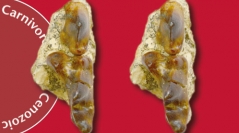

 Geodiversitas
42 (3) - Pages 29-45
Geodiversitas
42 (3) - Pages 29-45We document new materials of Tungurictis Colbert, 1939, a basal hyaenid (hyena family), from the Junggar Basin in northern Xinjiang Uygur Autonomous Region, northwestern China, and recognize a new species, T. peignei, n. sp., from the top of the Suosuoquan Formation through the top of the overlying Halamagai Formation. Associated upper and lower teeth, plus isolated lower jaws, are described, and collectively these span c. 17-14 Ma in local stratigraphic sections. The new species represents the smallest and most primitive form of Tungurictis, which gave rise to T. spocki Colbert, 1939 in the middle Miocene Tunggur Formation of Inner Mongolia. These two species of Tungurictis form an East Asian clade with slightly more hypercarnivorous dentition, in contrast to hypocarnivorous species of Protictitherium Kretzoi, 1938 in Europe and western Asia. This geographic divergence may reflect environmental differences between Europe and western Asia, on the one hand, and East Asia, on another.
Hyaenidae, China, Asia, Junggar Basin, Miocene, evolution, new species